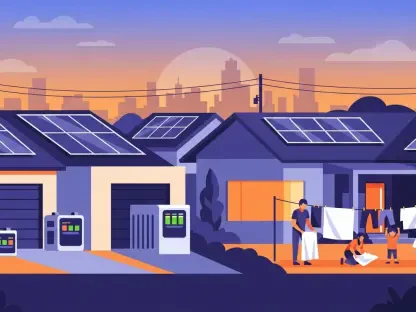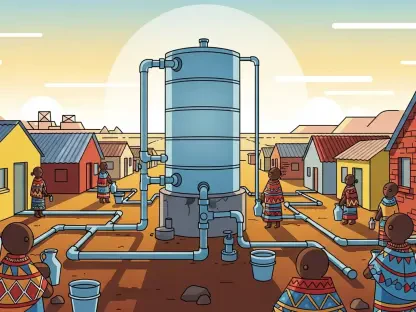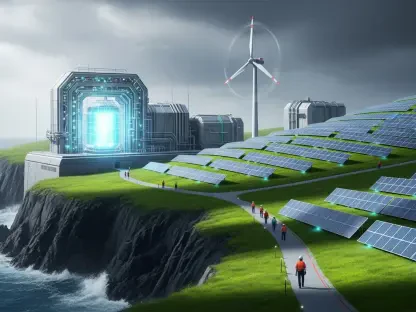Singapore, a compact island nation with a mere 0.1% contribution to global emissions, finds itself disproportionately vulnerable to the devastating effects of climate change, from rising sea levels to scorching heatwaves, and despite its small footprint, the city-state is not standing idly by. Under the guidance of Senior Minister of State for Sustainability and the Environment, Zaqy Mohamad, Singapore is crafting a visionary response to these existential threats. During a parliamentary debate on September 22, Zaqy unveiled a strategy grounded in long-term planning and unwavering political commitment. This approach isn’t about temporary fixes but about fortifying the nation for decades, even centuries, ahead. With substantial financial pledges and innovative projects, Singapore is setting a global benchmark for climate resilience, ensuring that future generations inherit a secure and thriving homeland.
Building a Resilient Foundation
Fortifying Coastal Defenses
Singapore’s low-lying geography makes it acutely susceptible to rising sea levels, a challenge that demands forward-thinking solutions. The government has committed an astounding $100 billion over the next century to coastal protection, drawing on national reserves with fiscal discipline to ensure sustainable funding. Projects like the Long Island development off the East Coast are central to this vision, aiming to create a fortified “ring of resilience” around the nation. Detailed site-specific studies are also underway to tailor defenses to unique geographic risks. This isn’t just about building walls; it’s about safeguarding critical infrastructure and communities against inevitable global climate shifts with meticulous engineering and strategic foresight, reflecting a dedication to long-term security over short-term gains.
Infrastructure with Broader Impact
Beyond mere protection, Singapore’s climate adaptation projects are designed to deliver multiple societal benefits, embodying a philosophy of added value. The Marina Barrage stands as a prime example—initially constructed for flood control and water supply, it has transformed into an iconic community space and cultural landmark. Such initiatives highlight how climate resilience can enhance quality of life, offering spaces for recreation and education while shielding against disasters. This dual-purpose approach ensures that investments in infrastructure are not only protective but also enriching, setting a model for integrating practical needs with societal progress. By embedding versatility into these projects, Singapore demonstrates a nuanced understanding of adaptation that prioritizes both safety and communal well-being for years to come.
Addressing Critical Resources and Sustainability
Ensuring Food and Water Stability
Climate change poses severe risks to Singapore’s food and water security, exacerbated by global disruptions like floods and droughts that strain supply chains. Zaqy Mohamad has underscored the need to diversify food sources and bolster local production to mitigate these vulnerabilities. Simultaneously, water conservation remains a top priority given the nation’s limited natural resources and rising demand from population growth and industrial activity. These strategies are not standalone fixes but integral parts of a broader resilience framework, ensuring that both citizens and industries can endure climate-induced shortages. Through careful planning and public engagement, Singapore aims to create a robust system that secures these essentials against unpredictable global patterns, safeguarding the foundation of daily life.
Adapting to Urban Heat Challenges
Rising temperatures present another formidable threat, impacting public health and urban livability across Singapore. A comprehensive, whole-of-government strategy is being developed to tackle heat through innovative urban planning, sustainable building designs, and heightened community awareness. A national heatwave response plan further outlines targeted actions, such as halting outdoor activities at eldercare facilities during extreme heat and transitioning schools to home-based learning when necessary. These measures address both the physical toll of rising temperatures and the social implications, ensuring vulnerable populations are protected. By weaving together policy, design, and public education, Singapore is crafting a multi-layered defense against heat stress, demonstrating a commitment to adapting urban environments to a warming world with practical and inclusive solutions.
Pioneering a Low-Carbon Future
Driving Green Economic Transitions
Singapore is steadfast in its pursuit of a low-carbon economy, even as global cooperation on climate action faces setbacks. The government is actively supporting businesses through incentives for energy efficiency, redirecting carbon tax revenues to fund green initiatives and low-carbon technologies. Partnerships with industries are also being forged to explore solutions like cross-border carbon capture and storage, while preliminary studies into nuclear science and safety are assessing future energy options. Though no final decisions have been made on nuclear adoption, these exploratory steps signal a willingness to innovate. This multi-pronged approach reflects a determination to reduce emissions while maintaining economic vitality, positioning Singapore as a leader in sustainable development amid complex global challenges.
Engaging Communities in Sustainability
At the household level, Singapore is fostering a culture of sustainability through actionable programs and public participation. Climate vouchers encourage the adoption of energy- and water-efficient appliances, with a significant number of eligible households already claiming these benefits as of recent data. Additionally, efforts to enhance waste management focus on reducing, reusing, and recycling to curb the growing waste challenge tied to consumption. These initiatives underscore the shared responsibility between government and citizens in building a sustainable future. By empowering individuals to make greener choices, Singapore ensures that national climate goals are supported by grassroots action, creating a cohesive effort that spans from policy to personal habits and strengthens overall resilience.
Reflecting on a Legacy of Foresight
Looking back, Singapore’s response to climate change, as articulated by Zaqy Mohamad, reveals a masterful blend of urgency and strategic vision. The nation tackles immediate threats like sea-level rise and urban heat with robust infrastructure and adaptive policies, while laying groundwork for sustainability through low-carbon innovations and resource security. Each initiative, from coastal defenses to community-driven sustainability programs, contributes to a legacy of resilience. As these efforts unfold, they offer a blueprint for balancing adaptation with societal enrichment. Moving forward, the focus should remain on refining the forthcoming national adaptation plan to address evolving risks dynamically. Exploring further international collaboration for technology and knowledge sharing could amplify impact. Ultimately, sustaining this momentum through continued political will and public engagement will be key to ensuring that the foundation built today endures for future challenges.









